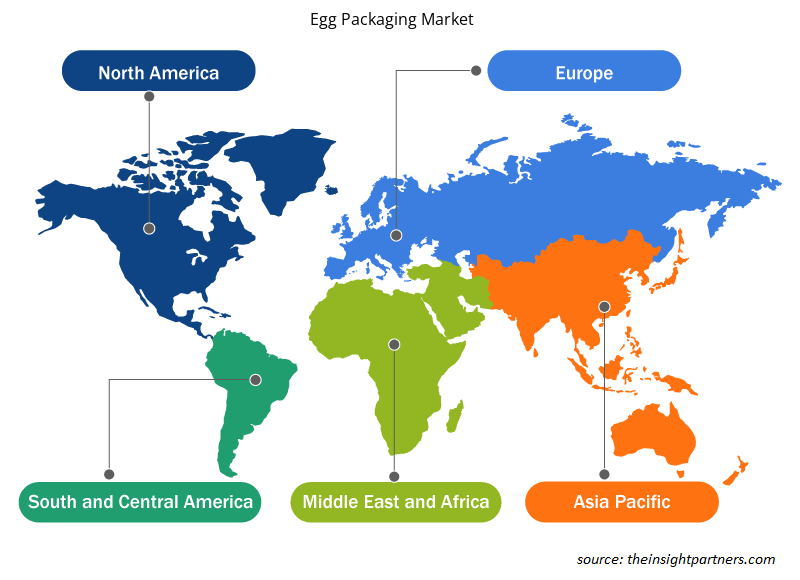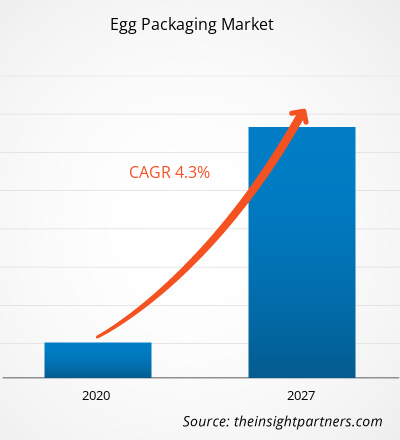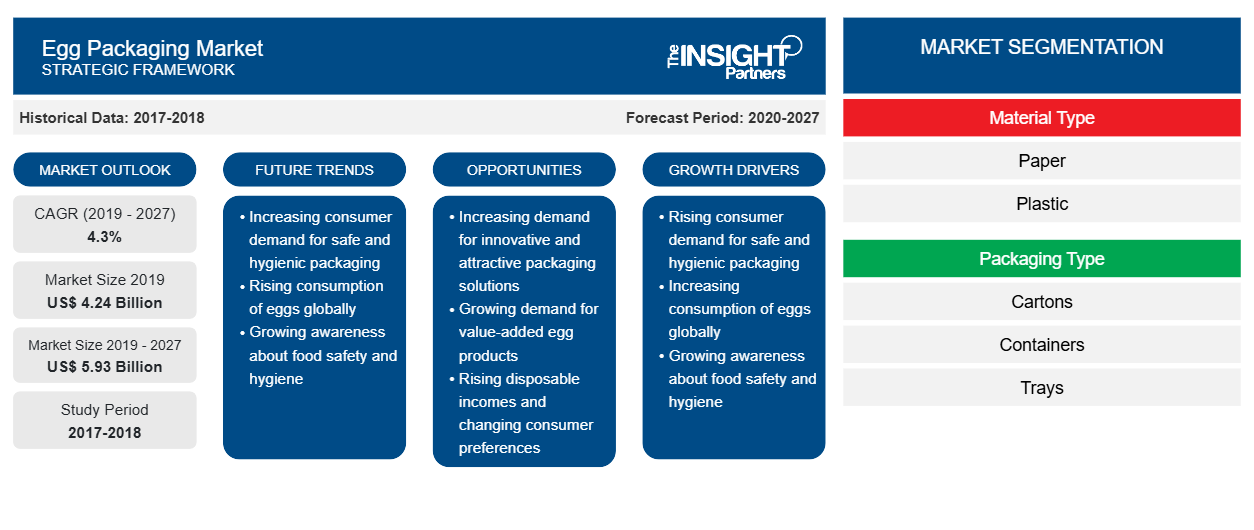Der Markt für Eierverpackungen hatte im Jahr 2019 einen Wert von 4.243,42 Millionen US-Dollar und soll bis 2027 einen Wert von 5.932,01 Millionen US-Dollar erreichen; von 2020 bis 2027 wird mit einer durchschnittlichen jährlichen Wachstumsrate von 4,3 % gerechnet.
Eierverpackungen sind Verpackungsmaterialien, die speziell für die sichere Lagerung und den Transport von Eiern entwickelt wurden. Die empfindliche und poröse Beschaffenheit von Eierschalen erfordert eine robuste und sichere Verpackungslösung. Kartons, Schalen, Körbe und Behälter sind einige der am häufigsten verwendeten Eierverpackungslösungen. Sie werden aus Karton, Recyclingpapier, Polyethylenterephthalat oder Polystyrol hergestellt. Diese Materialien sind praktisch und helfen auch dabei, die Belastungen oder Stöße abzufedern, die beim Umgang mit den Eiern oder beim Transport auftreten. Darüber hinaus schützt die Eierverpackung die Eier vor Bakterien, Verunreinigungen, natürlichen Feinden und Feuchtigkeitsverlust. All diese Vorteile haben die Nachfrage nach Eierverpackungen erhöht.
Im Jahr 2019 hatte Europa einen bedeutenden Anteil am Eierverpackungsmarkt . Allerdings wird erwartet, dass der asiatisch-pazifische Raum im Prognosezeitraum die am schnellsten wachsende Region sein wird. Das Wachstum des Eierverpackungsmarktes in Europa ist in erster Linie auf den steigenden Eierkonsum und die steigende Nachfrage aus der Gastronomie und Lebensmittelverarbeitungsindustrie zurückzuführen.
Der COVID-19-Ausbruch wurde erstmals im Dezember 2019 in Wuhan (China) gemeldet. Seit Februar 2021 gehören die USA, Brasilien, Indien, Russland, Spanien und das Vereinigte Königreich zu den am stärksten betroffenen Ländern in Bezug auf bestätigte Fälle und gemeldete Todesfälle. Der Ausbruch wirkt sich aufgrund von Lockdowns, Reiseverboten und Geschäftsschließungen negativ auf die Wirtschaft und Industrie in verschiedenen Ländern aus. Die Lebensmittel- und Getränkeindustrie ist eine der weltweit wichtigsten Branchen, die unter schwerwiegenden Störungen wie Unterbrechungen der Lieferkette, Absagen von Technologieveranstaltungen und Büroschließungen leidet. China beispielsweise ist das globale Produktionszentrum und der größte Rohstofflieferant für verschiedene Branchen und gehört zu den am schlimmsten betroffenen Ländern. Die Schließung verschiedener Werke und Fabriken in China hat die globalen Lieferketten eingeschränkt und die Produktionsaktivitäten, Lieferpläne und den Verkauf verschiedener Produkte gestört. Verschiedene Unternehmen haben bereits mögliche Verzögerungen bei Produktlieferungen und einen Einbruch des zukünftigen Verkaufs ihrer Produkte angekündigt. Darüber hinaus behindern die von Ländern in Europa, Asien und Nordamerika verhängten globalen Reiseverbote die Möglichkeiten für Geschäftskooperationen und Partnerschaften. Alle diese Faktoren beeinträchtigen die Lebensmittel- und Getränkeindustrie und wirken somit als Bremsfaktoren für das Wachstum verschiedener mit dieser Industrie verbundener Märkte.
Passen Sie diesen Bericht Ihren Anforderungen an
Sie erhalten kostenlose Anpassungen an jedem Bericht, einschließlich Teilen dieses Berichts oder einer Analyse auf Länderebene, eines Excel-Datenpakets sowie tolle Angebote und Rabatte für Start-ups und Universitäten.
-
Holen Sie sich die wichtigsten Markttrends aus diesem Bericht.Dieses KOSTENLOSE Beispiel umfasst eine Datenanalyse von Markttrends bis hin zu Schätzungen und Prognosen.
Markteinblicke
Bequemer Eiertransport wird immer beliebter
Die Eierverpackung ist ein wesentlicher Bestandteil, um den Verbrauchern hochwertige Eier anzubieten. Sie schützt die Eier vor Bakterien, Verunreinigungen, natürlichen Feinden und Feuchtigkeitsverlust. Außerdem schützt die Eierverpackung vor möglichem Zerdrücken während der Handhabung, Lagerung oder des Transports der Eier. Im Vergleich zu jedem anderen Schritt während der Verarbeitung und Verteilung gehen beim Transport viele Eier kaputt. Daher entsteht durch zerbrochene Eier ein wirtschaftlicher Schaden, da das Auftreten von Rissen das Risiko einer bakteriellen Kontamination der zerbrochenen Eier erhöht, was die Qualität mindert und Probleme hinsichtlich der Lebensmittelsicherheit verursacht. Daher werden zum Verpacken der Eier hauptsächlich Eierverpackungen in Form von Schalen, Kartons oder Kartons verwendet. Die Kartons bieten den Eiern den besten mechanischen Schutz. Die Kartons haben eine Noppenform und die Struktur schützt die Eier vor Belastungen und Stößen, die während der Lagerung und des Transports auftreten, und verringert so die mögliche Beschädigung oder das Zerdrücken der Eierschalen. Daher führen die Hersteller Eierkartons in verschiedenen Formen und Größen ein, um die Lagerung und den Transport der Eier zu erleichtern. Daher treibt die zunehmende Vorliebe für Eierverpackungsprodukte in Form von Schalen, Kartons oder Kartons für den Eiertransport das Wachstum auf dem Eierverpackungsmarkt voran.
Einblicke in Materialtypen
Basierend auf der Materialart ist der Eierverpackungsmarkt in Papier, Kunststoff und andere unterteilt. Das Papiersegment führte den Markt mit dem höchsten Marktanteil im Jahr 2019 an. Verpackungen auf Papierbasis schützen Waren und reduzieren Abfall, außerdem sind sie recycelbar. Das verantwortungsvolle Recycling von Altpapier und Verpackungen reduziert Abfall und Mülldeponien. Es verhindert Abfall durch Bruch, Verderb und Verunreinigung und verlängert die Haltbarkeit des Produkts. Verpackungen auf Papierbasis sind eine vielseitige und kostengünstige Methode zum Transportieren, Schützen und Konservieren einer breiten Palette von Artikeln. Sie sind robust und dennoch leicht konstruiert und können an produkt- oder kundenspezifische Anforderungen angepasst werden. Verpackungen auf Papierbasis werden aus Papierzellstoff hergestellt. Ihr Design hat sich seitdem nicht wesentlich verändert. Sie wurden eine Zeit lang durch PET-Verpackungen ersetzt, aber die Öffentlichkeit bevorzugte das natürliche Aussehen und die Haptik des Kartons aus Papierzellstoff. Eierkartons aus Papier sind biologisch abbaubar und werden von fast allen lokalen Recyclingagenturen akzeptiert. All diese Faktoren treiben das Wachstum des Eierverpackungsmarktes im Papiersegment voran.
Einige wichtige Marktteilnehmer sind Sonoco Products Company; Placon; Mauser Corporate GMBH; JIN FU HUA PACKAGING INDUSTRIAL CO., LTD.(JFH); Huhtamaki Oyj; CKF Inc.; Cascades Inc; Brodrene Hartmann AS; Reynolds Group Holdings Limited.; und Cellulose de la Loire. Wichtige Akteure auf dem Eierverpackungsmarkt konzentrieren sich auf Strategien wie Fusionen und Übernahmen sowie Produkteinführungen, um ihre geografische Präsenz und Kundenbasis weltweit zu vergrößern. Sonoco Products Company; Placon; Mauser Corporate GMBH; JIN FU HUA PACKAGING INDUSTRIAL CO., LTD.(JFH); Huhtamaki Oyj; CKF Inc.; Cascades Inc; Brodrene Hartmann AS; Reynolds Group Holdings Limited.; and Cellulose de la Loire. Major players operating in the egg packaging market are focused on strategies such as mergers and acquisitions, and product launches to increase their geographical presence and consumer base globally.
Regionale Einblicke in den Eierverpackungsmarkt
Die regionalen Trends und Faktoren, die den Eierverpackungsmarkt im Prognosezeitraum beeinflussen, wurden von den Analysten von Insight Partners ausführlich erläutert. In diesem Abschnitt werden auch die Marktsegmente und die Geografie des Eierverpackungsmarktes in Nordamerika, Europa, im asiatisch-pazifischen Raum, im Nahen Osten und Afrika sowie in Süd- und Mittelamerika erörtert.

- Erhalten Sie regionale Daten zum Eierverpackungsmarkt
Umfang des Eierverpackungsmarktberichts
| Berichtsattribut | Details |
|---|---|
| Marktgröße im Jahr 2019 | 4,24 Milliarden US-Dollar |
| Marktgröße bis 2027 | 5,93 Milliarden US-Dollar |
| Globale CAGR (2019 - 2027) | 4,3 % |
| Historische Daten | 2017-2018 |
| Prognosezeitraum | 2020–2027 |
| Abgedeckte Segmente |
Nach Materialtyp
|
| Abgedeckte Regionen und Länder |
Nordamerika
|
| Marktführer und wichtige Unternehmensprofile |
|
Dichte der Marktteilnehmer für Eierverpackungen: Die Auswirkungen auf die Geschäftsdynamik verstehen
Der Markt für Eierverpackungen wächst rasant, angetrieben durch die steigende Nachfrage der Endverbraucher aufgrund von Faktoren wie sich entwickelnden Verbraucherpräferenzen, technologischen Fortschritten und einem größeren Bewusstsein für die Vorteile des Produkts. Mit steigender Nachfrage erweitern Unternehmen ihr Angebot, entwickeln Innovationen, um die Bedürfnisse der Verbraucher zu erfüllen, und nutzen neue Trends, was das Marktwachstum weiter ankurbelt.
Die Marktteilnehmerdichte bezieht sich auf die Verteilung der Firmen oder Unternehmen, die in einem bestimmten Markt oder einer bestimmten Branche tätig sind. Sie gibt an, wie viele Wettbewerber (Marktteilnehmer) in einem bestimmten Marktraum im Verhältnis zu seiner Größe oder seinem gesamten Marktwert präsent sind.
Die wichtigsten auf dem Eierverpackungsmarkt tätigen Unternehmen sind:
- Sonoco Products Company
- Placon
- Mauser Corporate GMBH
- JIN FU HUA PACKAGING INDUSTRIAL CO., LTD. (JFH)
- Huhtamaki Oyj
Haftungsausschluss : Die oben aufgeführten Unternehmen sind nicht in einer bestimmten Reihenfolge aufgeführt.

- Überblick über die wichtigsten Akteure auf dem Eierverpackungsmarkt
Bericht-Spotlights
- Fortschrittliche Branchentrends auf dem globalen Eierverpackungsmarkt helfen den Akteuren bei der Entwicklung wirksamer langfristiger Strategien
- In Industrie- und Entwicklungsländern angewandte Strategien für Unternehmenswachstum
- Quantitative Analyse des globalen Eierverpackungsmarktes von 2017 bis 2027
- Schätzung der Nachfrage nach Eierverpackungen in verschiedenen Branchen
- PEST-Analyse zur Veranschaulichung der Wirksamkeit der in der Branche tätigen Käufer und Lieferanten bei der Vorhersage des Marktwachstums
- Aktuelle Entwicklungen zum Verständnis der Wettbewerbssituation auf dem Markt und der Nachfrage nach Eierverpackungen
- Markttrends und -aussichten in Verbindung mit Faktoren, die das Wachstum des Eierverpackungsmarktes vorantreiben und bremsen
- Entscheidungsprozess durch das Verständnis von Strategien, die das kommerzielle Interesse im Hinblick auf das Wachstum des globalen Eierverpackungsmarktes untermauern
- Größe des Eierverpackungsmarktes an verschiedenen Marktknoten
- Detaillierte Übersicht und Segmentierung des globalen Eierverpackungsmarktes sowie seiner Dynamik in der Branche
- Marktgröße für Eierverpackungen in verschiedenen Regionen mit vielversprechenden Wachstumschancen
Eierverpackungsmarkt nach Materialtyp
-
Papier
- Karton
- Recyclingpapier
- Sonstiges
-
Plastik
- Polyethylenterephthalat
- Polystyrol
- Sonstiges
- Sonstiges
Eierverpackungsmarkt, nach Verpackungstyp
- Kartons
- Behälter
- Tabletts
- Sonstiges
Firmenprofile
- Sonoco Products Company
- Placon
- Mauser Corporate GMBH
- JIN FU HUA PACKAGING INDUSTRIAL CO., LTD. (JFH)
- Huhtamaki Oyj
- CKF Inc.
- Cascades Inc
- Brodrene Hartmann AS
- Reynolds Group Holdings Limited.
- Zellulose aus der Loire
- Historische Analyse (2 Jahre), Basisjahr, Prognose (7 Jahre) mit CAGR
- PEST- und SWOT-Analyse
- Marktgröße Wert/Volumen – Global, Regional, Land
- Branchen- und Wettbewerbslandschaft
- Excel-Datensatz
Aktuelle Berichte
Verwandte Berichte
Erfahrungsberichte
Grund zum Kauf
- Fundierte Entscheidungsfindung
- Marktdynamik verstehen
- Wettbewerbsanalyse
- Kundeneinblicke
- Marktprognosen
- Risikominimierung
- Strategische Planung
- Investitionsbegründung
- Identifizierung neuer Märkte
- Verbesserung von Marketingstrategien
- Steigerung der Betriebseffizienz
- Anpassung an regulatorische Trends























 Kostenlose Probe anfordern für - Markt für Eierverpackungen
Kostenlose Probe anfordern für - Markt für Eierverpackungen